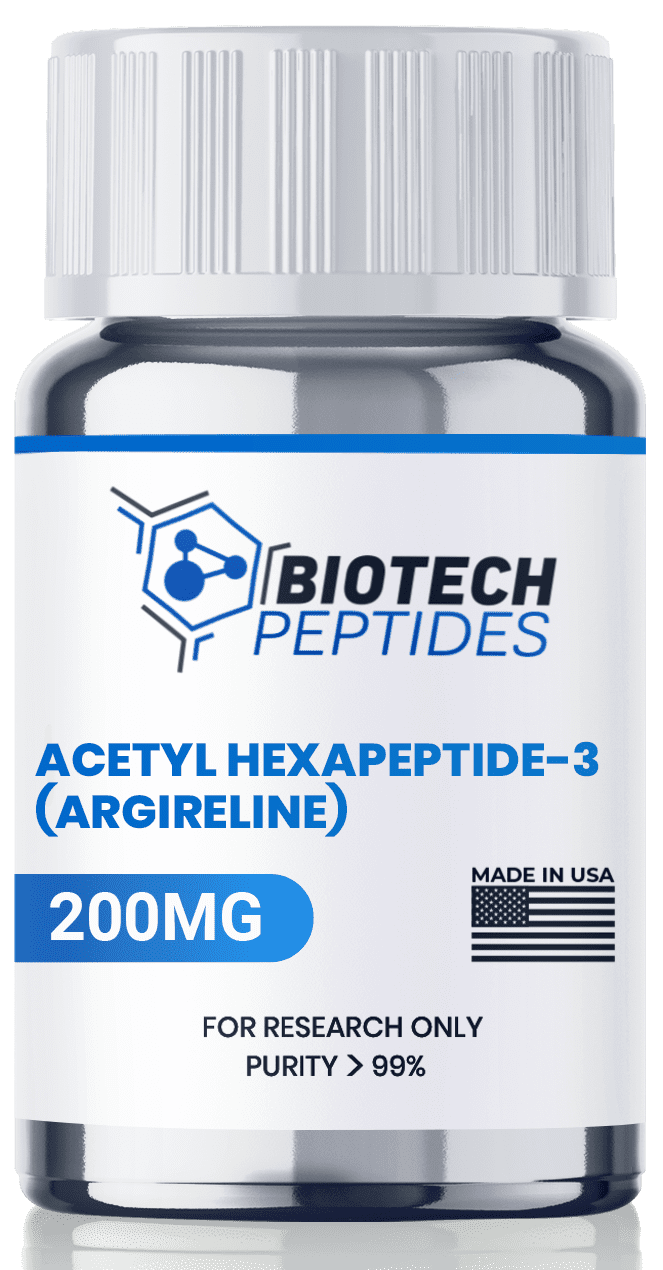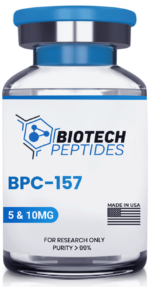No products in the cart
Acetyl Hexapeptide-3 (Argireline) (200mg)
$210.00
Acetyl Hexapeptide-3 (Argireline) peptides are Synthesized and Lyophilized in the USA.
Discount per Quantity
| Quantity | 5 - 9 | 10 + |
|---|---|---|
| Discount | 5% | 10% |
| Price | $199.50 | $189.00 |
FREE - 30ml bottle of bacteriostatic water
(Required for reconstitution)
FREE - USPS priority shipping
Description
Acetyl Hexapeptide-3 (Argireline) Peptide
Acetyl Hexapeptide-3 (Argireline) consists of multiple chains of amino acids. It is a fragment of the SNAP-25, a botulinum toxin substrate.[1] Researchers have investigated Acetyl Hexapeptide-3 (Argireline) for its potential to support skin cell structure and reduce wrinkling along the skin surface. Continuous muscle movements result in lines and wrinkles, and the devitalization of muscle contractions may possibly inhibit the development of new lines and decrease the depth of existing skin wrinkles. Acetyl Hexapeptide-3 (Argireline) may prevent muscles from moving or contracting. Researchers also posit that the peptide may support endogenous collagen production to preserve the skin’s extracellular matrix.
Specifications
Sequence: Ac-Glu-Glu-Met-Gln-Arg-Arg-NH2
Molecular Formula: C34H60N14O12S
Molecular Weight: 888.99g/mol
Synonyms: Acetyl hexapeptide, Argireline, Argireline Acetate
Acetyl Hexapeptide-3 (Argireline) Research
Acetyl Hexapeptide-3 (Argireline), according to research, may potentially act to reduce the depth of wrinkles and lines along the surface of skin through supporting the endogenous synthesis of proteins integral to the skin’s extracellular matrix, such as collagen.[2] Researchers noted that introducing the peptide alongside “functional [symbiotic compounds] can improve wrinkle with minimal discomfort.” Scientific research suggests that it may be a vital ancillary for reducing existing creases along the skin barrier, even as it works to support collagen production.
Acetyl Hexapeptide-3 (Argireline) studies report that its effects on wrinkles appear to be minimal.[3] On the other hand, the International Journal of Cosmetic Science research posits that its actions are functional and evident.[4] According to the research, a cream with a 10% concentration of Acetyl Hexapeptide-3 (Argireline) decreased the wrinkle formations of research models in a specific area by 30% after one month of exposure. Researchers used a serum consisting of Acetyl Hexapeptide-3 (Argireline) twice a day for a month. After which, the results posited a total decrease in periorbital wrinkle depth at 27%. The in vitro experiment suggests that the actions of Acetyl Hexapeptide-3 may potentially halt the release of neurotransmitters. Blanes-Mira et al. noted that “Taken together, these findings demonstrate that Argireline is a non-toxic, antiwrinkle peptide that emulates the action of currently used BoNTs” suggesting a reduction in wrinkle formation due to limited muscle contraction.[5]
Acetyl Hexapeptide-3 (Argireline) appears to have the potential to halt the production of the neurotransmitters that influence and control the contractile force of certain muscle groups. Acetyl Hexapeptide-3 (Argireline) may hamper the protein complex that controls muscle movement and limit muscle contractions via reducing the action of nerves that control contractions.
Disclaimer: The products mentioned are not intended for human or animal consumption. Research chemicals are intended solely for laboratory experimentation and/or in-vitro testing. Bodily introduction of any sort is strictly prohibited by law. All purchases are limited to licensed researchers and/or qualified professionals. All information shared in this article is for educational purposes only.
References
- Wang Y, Wang M, Xiao XS, Huo J, Zhang WD. The anti-wrinkle efficacy of Argireline. J Cosmet Laser Ther. 2013 Aug;15(4):237-41. doi: 10.3109/14764172.2013.769273. Epub 2013 Mar 6. PMID: 23464592.
- An JH, Lee HJ, Yoon MS, Kim DH. Anti-Wrinkle Efficacy of Cross-Linked Hyaluronic Acid-Based Microneedle Patch with Acetyl Hexapeptide-8 and Epidermal Growth Factor on Korean Skin. Ann Dermatol. 2019 Jun;31(3):263-271. doi: 10.5021/ad.2019.31.3.263. Epub 2019 May 1. PMID: 33911590; PMCID: PMC7992733.
- Wang Y, Wang M, Xiao S, Pan P, Li P, Huo J. The anti-wrinkle efficacy of argireline, a synthetic hexapeptide, in Chinese subjects: a randomized, placebo-controlled study. Am J Clin Dermatol. 2013 Apr;14(2):147-53. doi: 10.1007/s40257-013-0009-9. PMID: 23417317.
- Blanes-Mira C, Clemente J, Jodas G, Gil A, Fernández-Ballester G, Ponsati B, Gutierrez L, Pérez-Payá E, Ferrer-Montiel A. A synthetic hexapeptide (Argireline) with antiwrinkle activity. Int J Cosmet Sci. 2002 Oct;24(5):303-10. doi: 10.1046/j.1467-2494.2002.00153.x. PMID: 18498523
- Lim SH, Sun Y, Thiruvallur Madanagopal T, Rosa V, Kang L. Enhanced Skin Permeation of Anti-wrinkle Peptides via Molecular Modification. Sci Rep. 2018 Jan 25;8(1):1596. doi: 10.1038/s41598-017-18454-z. Erratum in: Sci Rep. 2018 Apr 20;8(1):6500. PMID: 29371611; PMCID: PMC5785486.
Additional information
| Brand | Biotech Peptides |
|---|
You must be logged in to post a review.





Reviews
There are no reviews yet.